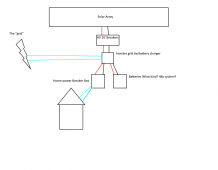I am looking to start working on a solar install i have been fiddling with solar for a while but not on this scale.
Here is what i am looking for.
I live in Texas were the weather is hot and humid the majority of the year and AC is really important for me because of my family. Texas did recently have a really bad i almost want to call it a grid failure. I did have a mobile backup generator and survived the freeze without many problems but had to go refuel it change the oil etc, but i would like something more permanent and have the generator as a supplemental power in case the batteries get low during the night etc.
The plan i was looking into was getting some of the Hybrid LV6048 6kW Grid tie hybrid deals and hook them up in series like the manual says you can do to get the 18kW etc. Reason for all of the power is the AC runs the majority of the day in the summer because of how hot it gets even though the house is insulated. I want to know if there is a better solution instead of buying multiple units and smashing them together to get the wattage i need. More of a single higher wattage unit (does not have to charge batteries).
As for the panels themselves i was looking into mount them on the ground in a large array with an adjustment function to change for winter/summer angles. A few points on these i have questions for.
Next step in my mind is what kind of fuses/breakers do i need? Do i get a dc breaker box before i put it into my Grid tie/solarmppt system?
Long story short i could use some help figuring out the wattage on all of this with a system and batteries to function in another grid failure caused by weather or whatever along with day to day savings of not paying the grid for power.
Linked is a png of what i was thinking.
UPDATE: I did an Audit and i am looking at about 1500kw per month needed i would need a system that would produce that during the summer in the winter we have a gas heater.
Here is what i am looking for.
- Power a 4Ton AC central air (240V) Upstairs is 120V
- Misc computers/server's i have 2 gaming computers and a laptop for my mom (Gaming computers are not playing games the whole day call it 2 hours each night)
- Networking Closet i have with nas pulls about 300w
- Keep the lights on fridge freezer etc. 1 Fridge freezer combo and 2 deep freezers
I live in Texas were the weather is hot and humid the majority of the year and AC is really important for me because of my family. Texas did recently have a really bad i almost want to call it a grid failure. I did have a mobile backup generator and survived the freeze without many problems but had to go refuel it change the oil etc, but i would like something more permanent and have the generator as a supplemental power in case the batteries get low during the night etc.
The plan i was looking into was getting some of the Hybrid LV6048 6kW Grid tie hybrid deals and hook them up in series like the manual says you can do to get the 18kW etc. Reason for all of the power is the AC runs the majority of the day in the summer because of how hot it gets even though the house is insulated. I want to know if there is a better solution instead of buying multiple units and smashing them together to get the wattage i need. More of a single higher wattage unit (does not have to charge batteries).
As for the panels themselves i was looking into mount them on the ground in a large array with an adjustment function to change for winter/summer angles. A few points on these i have questions for.
- Do i need micro inverters to help with efficiency? They are not very expensive.
- With the micro inverters do i need a system that can "smart" talk to them?
- What panels can take a beating against large hail etc yet cost effective. Could i add some Plexiglass/laminate infront of the already protected cells to keep them from getting destroyed before a storm?
Next step in my mind is what kind of fuses/breakers do i need? Do i get a dc breaker box before i put it into my Grid tie/solarmppt system?
Long story short i could use some help figuring out the wattage on all of this with a system and batteries to function in another grid failure caused by weather or whatever along with day to day savings of not paying the grid for power.
Linked is a png of what i was thinking.
UPDATE: I did an Audit and i am looking at about 1500kw per month needed i would need a system that would produce that during the summer in the winter we have a gas heater.
Attachments
Last edited:



